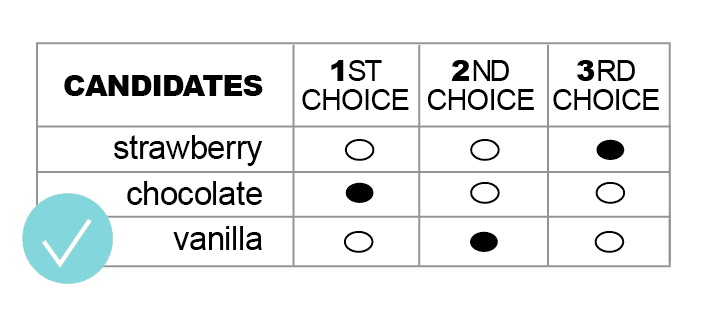Why choose ranked-choice voting as an election method? Jurisdictions adopting RCV do so for several reasons, from saving money to increasing civility in campaigns.
Eliminate Unnecessary Primary and Runoff Elections
In some jurisdictions without ranked-choice voting, if no candidate has a majority of the votes after the first primary or election, then a second election takes place in which only the two candidates with the most support in the first election run. Those candidates must campaign again - often in a very negative head-to-head race - and voters must return to the polls to vote again. Whether this runoff election occurs in a primary or Election Day, turnout often plummets in the second round.
With ranked-choice voting, a jurisdiction can get the benefit of two rounds of voting in a single, more representative, higher turnout election. That is why ranked-choice voting is often called “instant runoff voting.” In this context, RCV can save the jurisdiction a lot of money - the entire cost of a second election - while helping promote majority support and civil campaigning. Additional election cost has been the motivation for the adoption of RCV in places like San Francisco (replacing runoffs) and Minneapolis (replacing primaries).
Increased Civility in Campaigns
In non-ranked choice voting elections, candidates often turn to “mud-slinging” by attacking an opponent’s character instead of sharing their positive vision with voters. With ranked-choice voting, candidates do best when they reach out positively to as many voters as possible, including those supporting their opponents. A comprehensive Rutgers University poll of voters in 7 cities with ranked-choice voting found that voters report friendlier campaigns and that RCV had majority support in all the cities using it. Reports on the impact of ranked-choice voting on civility in elections are available from FairVote.
Promoting Fair Representation
All states and all congressional elections currently use winner-take-all rules that often elevate district lines over voters. Legislatures elected by winner-take-all may lead to distortions in partisan representation, the entrenchment of incumbents in safe seats, regional polarization, and low representation of women and racial and ethnic minorities. When combined with multi-winner districts electing at least three members, ranked-choice voting helps to make elections fairer and more reflective in every district. RCV ends the cycle of gerrymandering and creates competitive elections in which every vote counts.
Cambridge, MA, has, since 1941, elected its nine-member Council and six-member School Committee using Proportional Representation (PR). As Cambridge’s voter information brochure notes, “Under PR, any group that numbers more than one-tenth of the voters may elect at least one member of the City Council.” Its ethnically diverse and geographically mixed population makes this form of Ranked Choice Voting particularly attractive to the City of Cambridge.
Avoid Vote-Splitting and Weak Plurality Results
Spoiler effect has long been a point of contention in close political contests, where a third candidate appears to have drawn first-choice votes away from one candidate in a closely contested race. Ranked-choice voting allows these voters’ full range of preferences reflected in the outcome.
Also, in races with numerous candidates, the winning candidate frequently receives less than 50% of the vote. In such contests, the leading candidate may receive a weak plurality of the vote. Examples from the San Francisco Board of Supervisors elections demonstrate how ranked-choice voting yields a majority or, at least, strong plurality winners in such elections.
San Francisco Board of Supervisors, Selected Election Results |
||||||
Year |
Number of Candidates |
District |
Winner's First Choice % of Valid Ballots |
Winner's Final % of All Valid Ballots |
Winner's % of Final Round Ballots |
|
2006 |
6 |
District 4 |
26.2% |
42.3% |
52.5% |
|
2008 |
8 |
District 11 |
28.2% |
41.4% |
52.9% |
|
2012 |
8 |
District 5 |
28.0% |
42.5% |
56.2% |
|
2012 |
9 |
District 7 |
29.3% |
39.8% |
50.3% |
|
Similarly, in the 2013 Mayoral contest in Minneapolis, with 35 candidates, Betsy Hodges received 36% of the 1st choice votes, followed by 61% of the vote in the final round of tabulation.
Recent Gubernatorial elections in Maine, where strong independent candidates led to the election of governors without majority support (in one case less than 40%) contributed to Maine voters’ 2016 adoption of RCV for its statewide and General Assembly elections.
"We consider it an unqualified success. We've heard nothing but good things from voters about it. In the past, UOCAVA voters had a very difficult time participating in runoffs due to the two-week turnaround time. In the June 2012 primary, 92.5% of UOCACVA primary voters also participated in the runoff [with ranked ballots]. That is exceptional, and doesn't take into account those voters who may not have had a runoff. The real participation rate could be closer to 100%."





0 Comments